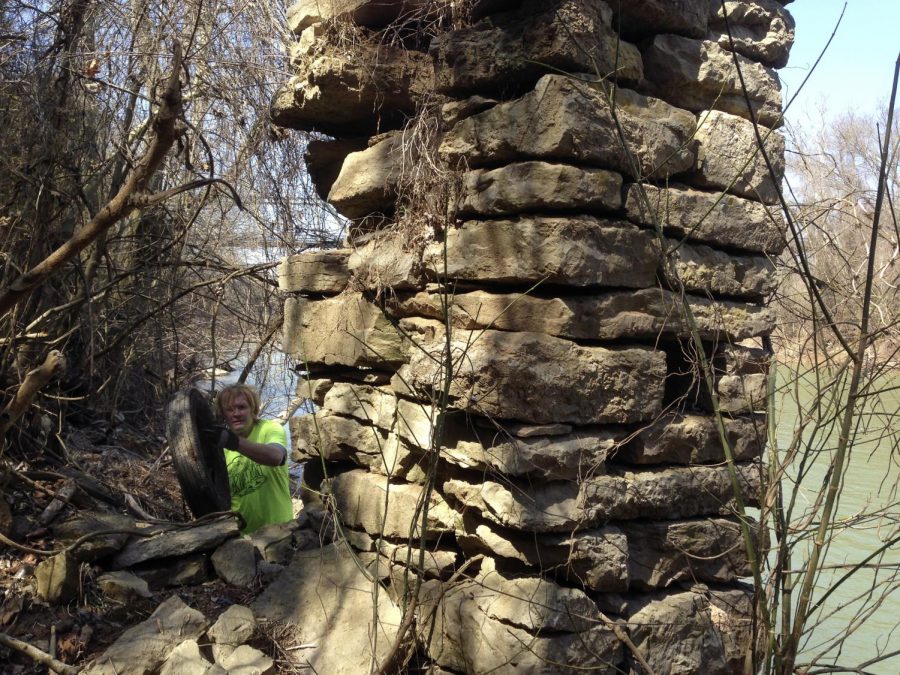Riverfront Foundation looks to create outdoor recreation facility
April 1, 2014
A gem lies hidden on the banks of the Barren River, between the College Street pedestrian bridge and the Old Louisville Road Bridge. It’s a one square-mile plot of land offering hiking paths and the promise of more outdoor activities.
The Bowling Green Riverfront Foundation is a non-profit organization that was created to plan, manage and fundraise for the redevelopment of the Barren River Outdoor Center, connecting the College Street Walking Bridge, the Old Louisville Road Bridge and Weldon Peete Park.
University photographer Clinton Lewis is the Bowling Green Riverfront Foundation’s current president. BGRF spawned from the original Whitewater Course for the Barren River which was introduced in 2005 by Steve Spencer.
“[The Whitewater Course] ended up not working out so it kind of laid low for a couple years and then it was resurrected by our first president, Paul Ress, who … wanted to get the project going again,” Lewis said.
Together, Lewis and Ress decided that expanding the user base would increase interest in the cause.
“We figured we’d have a better shot with a wider user base so we incorporated some rock climbing and we partnered with the chapter of the Kentucky Mountain Bike Association,” Lewis said.
That partnership created a Low Hollow Mountain Biking Trail — 3.2 miles of mountain bike trail circling Weldon Peete Park.
The completion of the biking trail ended phase one and introduced phase two, involving hopes for a BMX pump track that will be on a landfill site.
“We envision that to be actually on the landfill site because that’s the only thing that we can use the landfill site for,” Lewis said. “It’s still classified as an active landfill and there’s only a three-foot clay cap and some topsoil. So, it’s not load bearing at all so we can’t build or dig anything.”
Lewis said the topography of the pump track would work well in that it doesn’t require digging or putting in concrete footers.
Last weekend was BGRF’s first trash cleanup, which pulled hundreds of pounds of trash and garbage from both sides of the river between the two bridges.
While the organization anticipates having another trash cleanup this spring, they’re mostly focused on tree removal.
“There are some trees that we’ve identified that we’d like to remove from the river that have posed a risk to boaters and swimmers in the river,” Lewis said. “We know we can’t stop people from using the river, we don’t want to stop people from using the river, but we want to make it safer.”
John All, an associate professor in the Geography & Geology Department, looks at sustainable development and environmental planning, making him a prime candidate to help develop and expand BGRF.
“It’s a big space, why don’t we make it broad enough that it’ll appeal to everybody,” All said. “Let’s provide something that isn’t close by.”
If you live in Bowling Green and you’re a rock climber or mountain biker, All pointed out, it’s almost like a desert.
In fact, the next closest place offering all three components — mountain biking, paddling/whitewater rafting and rock climbing — is in Charlotte, N.C., an eight-hour drive from Bowling Green.
All asked his environmental planning class what they thought should be included on the riverfront.
“I had thought mountain biking, fishing, a walkway and picnic areas,” he said. “But they were bringing in things like rope challenge courses and frisbee golf, organic gardens, we talked about doing an orchard out there, and things like sustainable gardening techniques … It’s big enough and there’s enough space that you really could do quite a bit.”
For now, it’s a question of funding and interest.
“We have our website which is bgriverfront.org and we are also on Facebook,” Lewis said. BGRF has committed to sending a free T-shirt to every one hundredth ‘like’ on the Facebook page.
“We’re just trying to get people involved because it’s a great project and it’ll be really unique for this area to have mountain biking, climbing and paddling all within a central location roughly one square miles,” he added. “There’s lots of places around that have one or two components but not all three so we feel that’ll really make it a great destination for human powered recreation.”
The newly reformed recreation and administration club, ORAC, and other groups have reached out to BGRF to get involved and help on certain projects. Two groups in All’s environmental planning class used the riverfront for their final project.
“They became really excited to work on an actual, real project and not something that’s just in theory,” Lewis said.
“They could go down to the actual site, walk the area, and get real data and ended up they had fantastic projects because it was a real, actual project.”
Lewis and All see huge potential within the space and are eager to develop it for the community to use.
“It’s such a unique project that it’ll really make for a special area and will bring in lots of human powered recreation and adventure enthusiasts,” Lewis said. “It’ll be centrally located down at the river so it’ll be an easy bike ride from campus and we just definitely want people to get involved when we have it successful and be built.”
All realizes the need for a large outdoor recreation area grows as surrounding cities expand their own river fronts.
“For us not to develop it would be a huge waste,” All said. “This is a good opportunity. If the community wants to see a riverfront, now is the time to work on it.”






















![Megan Inman of Tennessee cries after embracing Drag performer and transgender advocate Jasmine St. James at the 9th Annual WKU Housing and Residence Life Drag Show at Knicely Conference Center on April 4, 2024. “[The community] was so warm and welcoming when I came out, if it wasn’t for the queens I wouldn’t be here,” Inman said.](https://wkuherald.com/wp-content/uploads/2024/04/smith_von_drag_3-600x419.jpg)


